St Columkille’s RC Church, Jindabyne
Contributed by Steve Williamson <sw-trout-at-snowy-net-au> (The dash after sw is a dash)
|
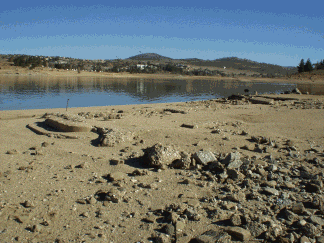
|
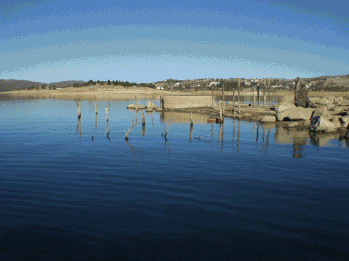
|
|
The front steps leading into St Columkille’s
|
"Sunny Brae" cottage is often dived on in the lake but these ruins of the water tank, and yard. Looks like an old oil tank in the water as well. |
|
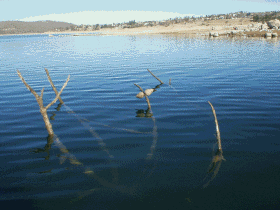
|
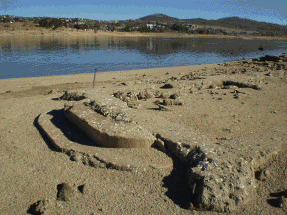
|
| Pine Trees surrounding St Columkille’s still have pine cones attached, ready to burst into life again should the lake ever lower. |
Church steps to town - shows the foundations of the whole church
|
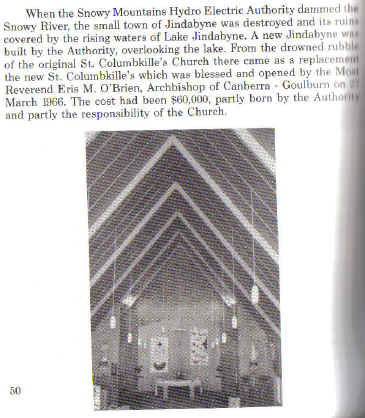 |
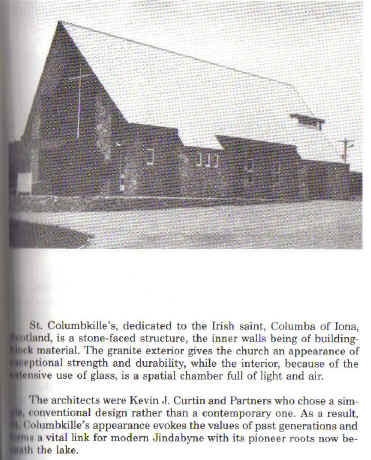 |
The present low water levels at Lake Jindabyne have created a bonus for those people interested in the history of the old township of Jindabyne.
Ruins of old structures are now surfacing from the deep dark depths of the lake where they have been immersed since the final construction of Jindabyne dam in 1967.
The foundations of the famous fishing lodge, ‘The Creel’ found on the banks of the Thredbo (Crackenback) River,’ at ‘Waste Point’ are now visible and many other structures like those surrounding properties such as ‘Sunnybrae Cottage’ can be seen ‘high and dry’.
However of all the structures now visible, it would have to be the ruins of the famous old Jindabyne Roman Catholic Church ‘St Columkille’s’ that would have to be the most interest.
Once standing high on a hillside overlooking the old township of Jindabyne and the famous Snowy River ‘St Columkille’s’ was one of the unfortunate obstacles standing in the way of progress.
Built mainly of sand and pebbles reclaimed from the Snowy River and mixed with cement, this concrete structure was demolished and not moved like a lot of buildings that were relocated to the new township.
For many years it has been a local myth, that when the lake level drops, the steeple of the old church would become visible.
This may have be a great story to tell the tourists, however the truth is that the hill top where the church ruins are now found is actually well known to locals as ‘Church Island’, visible as a small rocky outcrop during the low lake levels experienced most winters.
However, the lake is not normally low enough to see the church foundations and these have only been assessable to the scuba divers that dive on the old Jindabyne site over the summer months.
Anglers who often ‘troll’ for trout in Lake Jindabyne, would of course know that most of the fish are found hanging around the old church every Sunday morning.
Church Island is now so far out of the water that it is now possible to boat out to the island and walk around the old church ruins. You can also now walk up the front steps leading into the church.
There is not a lot left of the church, bits of wood, nails, pipe, wires and glass, but there is an eerie feel about the site where many years ago people would be christened, married and of course buried.
Today the only residents of the island are the seagulls, who too will have to move to a new home come spring, when once again the lake level will rise, sending ‘St Columkille’s’ back into the depths of Lake Jindabyne.
According to Snowy Hydro, over the next two years, while the construction of the new Jindabyne spillway takes place, we will have another two chances to visit the old ‘St Columkille’s’ site.
The lake will again be lowered in Autumn 2005, for the construction of the new intake and again in late 2006 when the lake is again lowered to take away the temporary ‘coffer dam’.
After that who knows how many years it will be before we again see the ruins of old Jindabyne.
Presently, Steve Williamson of ‘Lake Jindabyne Trout Fishing Adventures’ is offering private boat charters out to ‘Church Island’ where you too will be able to experience the excitement of this historical site.
Steve can be contacted on 0408 024436 or 64 561342 BH.
Steve would also welcome contact with anybody that could provide any historical information about St Columkille’s.





